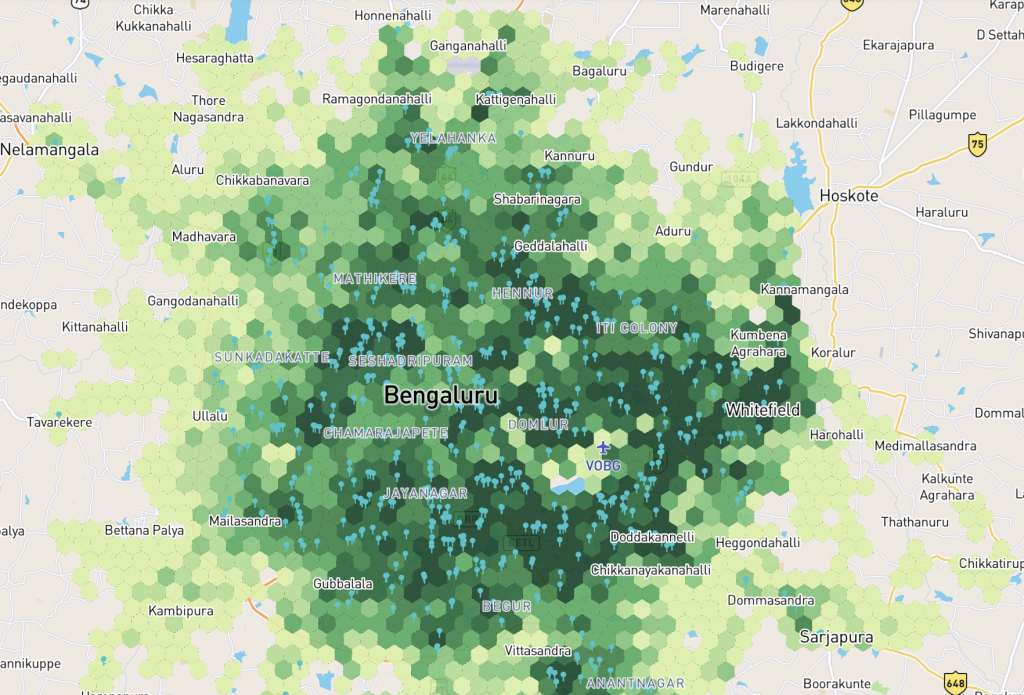“Where to open my retail store?”
This question haunts retailers worldwide.
Retail expansion requires significant capital investments. Thus, the onus is on the retailer to achieve profitability to pay back the investments. Resulting in retailers adopting strategies to reduce the break-even time.
But, this is predicated on the identification of a profitable location.
Poor location selection can,
- Reduce profitability
- Increase pay-back time
- Increase the risk of potential store closure
- Leading to Bankruptcy
Whitespace analysis is a store-expansion strategy in which retailers leverage data to identify profitable locations with a high density of the target audience but with low competition and no cannibalization.
This article will assist you in developing a comprehensive understanding of whitespace analysis in retail. We provide examples of how businesses can incorporate whitespace analysis in their expansion strategy.
What Is Whitespace Analysis in Retail?
Imagine an artist’s blank canvas—a vast, pristine expanse of white brimming with untold potential.
Whitespace analysis is similar to this concept.
If the present trade areas where a retail brand operates are smudged with different colors, whitespace refers to a pristine location.
Why Should Retailers Employ Whitespace Analysis?
Imagine if you are going to open a store in Bangalore.
The first step of any expansion strategy is to ascertain the presence of a target audience within the city.
For this, you will need a map of the Total Addressable Market in the city.
What is TAM?
Total Addressable Market (TAM) is a fundamental concept in business strategy and market analysis. At its core, TAM represents the entire revenue opportunity that exists for a specific product or service within a defined market. In simpler terms, it’s the maximum revenue a business could potentially generate if it captured 100% of the market demand for its offering.

With the help of a TAM map, the brand can identify the locations with the highest densities of their target audience.
For example, when the expansion team of the brand looks at the above image, they will be able to ascertain the presence of the target audience in locations with a higher density of green while locations with a lighter shade of green represent areas with a lower presence of the target audience.
Whitespace analysis helps retailers identify profitable locations, with low competition and no cannibalization.
Advantages of Applying Whitespace Analysis For Retail Expansion
- Reduce the time taken to scout a profitable location
- Remove gut-based strategies from site selection
- Pinpoint optimal site locations
How Do Retailers Leverage Insights from Whitespace Analysis?
Whitespace analysis provides compelling evidence of a company’s growth prospects, bolstering credibility and attracting investor interest.
For example, imagine you are a retail brand that discovered a whitespace in the city you want to expand into, this space has low competition and no same-store cannibalization. This analysis helps investors understand the marketability of that location.
Moving into an ideal location such as above allows a brand to develop a first-mover advantage. An advantage that helps cement brand loyalty helps them create an advantageous market position.
Difference between Whitespace Analysis and Void Analysis
In essence, whitespace analysis is distinct from void analysis, which focuses on determining suitable retail categories for specific locations. While void analysis addresses market gaps in terms of product offerings, whitespace analysis identifies untapped market opportunities, guiding retailers toward expansion success.
How to Perform a Retail Whitespace Analysis
- The first step in whitespace analysis is to identify the existence of the target audience within the selected catchment area.
- Pinpoint revenue-generating locations and eliminate non-viable options based on demographic segmentation. For example, a catchment of mostly 60-year-olds wouldn’t purchase products aimed at GenZ.
- Overlay trade areas of same-brand stores over the TAM map.
- Add locations of competitors on the TAM map.
- Identify whitespace areas with a high TAM density but low competitor presence and no cannibalization.
Conclusion
Whitespace analysis in retail offers a strategic approach to identifying lucrative expansion opportunities based on comprehensive data insights.
By leveraging this methodology, retailers can,
- Streamline site selection
- Anticipate consumer needs
Ultimately, whitespace analysis empowers retailers to unlock new avenues for expansion, establish a stronger market presence, and propel their brands toward sustained success in today’s competitive retail landscape.
Employing custom-built AI solutions provided by RetailIQ enables retailers to effortlessly identify locations with the presence of their target audience without their competitors.
What is RetailIQ?
RetailIQ is a cutting-edge AI solution revolutionizing offline expansion for the retail section. It is built on top of extensive location data and brand data to give street-level answers to expansion problems.
RetailIQ is a powerful tool providing site recommendations to maximize success at the store level and minimize the risk of closure. It also helps identify the total addressable market, conduct competition analysis, better understand your target audience traits and their presence, and perform detailed site analysis and reports, all adding up to a successful expansion strategy.


